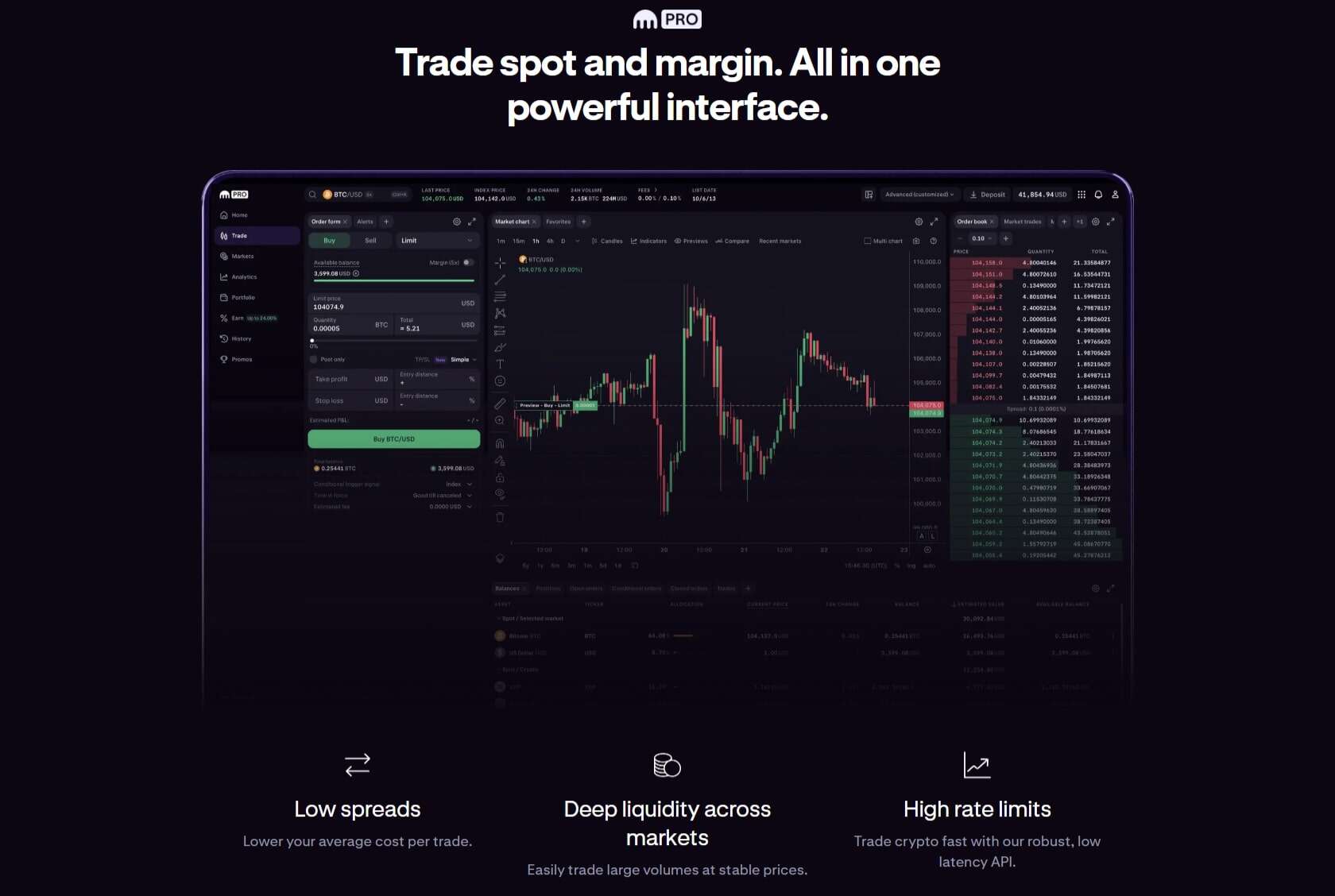When venturing into the intricate web of cryptocurrency trading, choosing the right exchange is paramount. In this crypto exchange comparison, we focus on two prominent platforms: Poloniex and Kraken.
Both have carved out significant niches in the market and offer a range of services to their users. In this detailed examination, we’ll dissect the unique selling points, the ease of use, and other critical aspects to help you navigate these digital currency hubs. When venturing into the intricate web of cryptocurrency trading, choosing the right exchange is paramount.
In this crypto exchange comparison, we focus on two prominent platforms: Poloniex and Kraken. Both have carved out significant niches in the market and offer a range of services to their users.
At a glance
| Category | Poloniex Our review is based on the spot trading platform. Please check our methodology on how we rate exchanges for further information. | Kraken Our review is based on the spot trading platform. Please check our methodology on how we rate exchanges for further information. |
|---|---|---|
| Headquarters Location | Boston, Massachusetts, USA | International |
| Fiat Currencies Supported | USD, AUD, GBP, CAD, EUR, NZD + 86 others (through third party apps) | USD, AUD, GBP, CAD, EUR + 1 other |
| Total Supported Cryptocurrencies | 487+ | 438+ |
| Trading Fees | -0.005% - 0.2% | 0.08% - 0.40% |
| Deposit Methods | Bank Transfer, Debit Card, Credit Card, Cryptocurrency, Apple Pay, Google Pay, Mercuryo, Simplex | Bank Transfer, Debit Card, Credit Card, Cryptocurrency, Paypal, Apple Pay, Google Pay, PayID, Osko |
| Support | Twitter, Help Center Articles, Support Ticket | Facebook, Twitter, Instagram, Live Chat, Help Center Articles, Support Ticket |
| Mobile App | Yes - iOS, Android | Yes - iOS, Android |
| Our Rating | ||
| Review | Read full Poloniex review | Read full Kraken review |
| Visit | Visit Poloniex | Visit Kraken
Don’t invest unless you’re prepared to lose all the money you invest. This is a high-risk investment and you should not expect to be protected if something goes wrong. Take 2 mins to learn more. |
About Poloniex Our review is based on the spot trading platform. Please check our methodology on how we rate exchanges for further information.
Poloniex is a Delaware-based exchange that has been operating since 2014. It has gained traction in the industry for providing users with access to a wide variety of digital assets.
Poloniex prides itself on its advanced trading features, which cater especially to more experienced crypto traders. Over time, it has built a reputation for offering a robust trading platform. Evolution through innovation and adapting to new market demands is a hallmark of a resilient cryptocurrency exchange.

One exchange’s journey is marked by its expansion into various innovative trading services and a persistent quest for providing a seamless trading environment. This evolution has been shaped by both positive advancements in technology and the lessons learnt from challenging periods, reflecting the dynamic nature of the cryptocurrency industry.
Poloniex Pros & Cons
Pros
Cons
About Kraken Our review is based on the spot trading platform. Please check our methodology on how we rate exchanges for further information.
Kraken, on the other hand, is a San Francisco-based cryptocurrency exchange established in 2011. It is one of the oldest and most popular exchanges, known for its extensive range of digital assets and fiat currency trading capabilities.
Kraken has been lauded for its security measures and commitment to regulatory compliance, making it a trustworthy platform for both novice and seasoned investors. Since its inception, another leading exchange has been at the forefront of cryptoeconomic research and development, contributing to the establishment of industry standards. Its growth trajectory includes strategic partnerships and expansion into new territories, underpinning its mission to facilitate seamless access to cryptocurrency markets globally.

The exchange’s commitment to staying abreast with evolving regulatory landscapes has fortified its position as a stalwart in the digital finance realm.
Kraken Pros & Cons
Pros
Cons
Don’t invest unless you’re prepared to lose all the money you invest. This is a high-risk investment and you should not expect to be protected if something goes wrong. Take 2 mins to learn more.
Poloniex vs Kraken: Supported Cryptocurrencies
In terms of total cryptocurrencies available, Poloniex users have access to more cryptocurrencies. Poloniex offers 487 cryptocurrencies whereas Kraken supports 438 cryptocurrencies.
For those interested in trading high market cap cryptocurrencies, Poloniex supports 23 of the top 30, compared to Kraken which supports 23 of the top 30.
Poloniex provides access to a wider range of cryptocurrencies, making it a potential go-to for traders seeking a diverse range. However, Kraken remains a strong competitor with its offerings.
Poloniex vs Kraken: Fees
| Fee Type | Poloniex Fees | Kraken Fees |
|---|---|---|
| Deposit Fee (Bank Transfer) | 3.95% | $0 USD - $5 USD |
| Deposit Fee (Credit Card/Debit Card) | 3.50% - 5% | Not Listed |
| Trading Fee | -0.005% - 0.2% | 0.08% - 0.40% |
| Withdrawal Fee (Bank Transfer) | 1% | $0 USD - $35 USD |
Regarding fees, both Poloniex and Kraken adopt a tiered structure, based on the user’s trading volume. This approach rewards users with higher volumes by offering reduced fees.
Both exchanges generate revenue from trading fees, which include costs associated with making trades as well as withdrawing funds. Kraken and Poloniex both aim to provide competitive fee structures to attract and retain customers in the dynamic crypto market. In a landscape where cost-effectiveness is key to attracting a broad user base, both platforms employ strategies to balance affordability with maintaining a high-quality service.
Innovative fee strategies are designed to cater to the diverse needs of crypto users, from casual enthusiasts to big-time traders, ensuring the platforms remain both accessible and appealing to a global audience. This fine balancing act is pivotal for maintaining a competitive edge in the fast-paced world of cryptocurrency trading.
Poloniex vs Kraken: Security
Security is at the forefront of any crypto exchange’s infrastructure. Kraken emphasises bullet-proof security and has a strong track record, having never been hacked.

It adheres to strict regulatory standards, adding a layer of trust for its users. Poloniex also prioritises security, although its history includes a significant hack in 2014.
Since then, it has taken extensive measures to bolster its security, ensuring safer transactions for its customers. In an era where digital assets are as valuable as traditional securities, the emphasis on robust security protocols is unparalleled. Adopting state-of-the-art encryption and multi-factor authentication methods are just the tip of the iceberg for exchanges committed to safeguarding user funds and data.
Each exchange has its own approach to creating a fortress-like environment, ensuring that the trust placed in them by their clientele is well-founded.
Poloniex vs Kraken: Ease of use
Kraken provides a user-friendly experience, offering a friendlier user interface functionality that appeals to both beginners and advanced users. The platform provides comprehensive feature analysis charts and tools to assist users in navigating the crypto trading landscape.

Poloniex, with its focus on advanced traders, offers a more complex platform that may be less intuitive for new users but includes detailed tools and features that experienced traders appreciate. Recognising that the user journey is as important as the destination, the objective is to provide a frictionless experience from the initial sign-up process to the finalising of trades. Tailoring the user interface to cater to individual preferences, facilitating a range of investment strategies and providing comprehensive educational resources are integral to achieving high user satisfaction.
These platforms strive to streamline the complexities of cryptocurrency trading into an enjoyable and intuitive user experience.
Poloniex vs Kraken: Support
Customer support is critical in the cryptocurrency exchange sphere. Kraken is renowned for its helpful customer service, providing timely and informative responses to users’ inquiries.

Poloniex also offers support channels, although feedback from users suggests that the response time may vary. Both exchanges strive to maintain active communication with their users, ensuring they can trade with confidence and receive assistance when needed. An exchange’s dedication to its users is often most visible through its support offerings.
The commitment to excellent customer service involves not just addressing queries but also anticipating the needs and challenges faced by traders. By maintaining a keen focus on user feedback and continuously refining support channels, these platforms demonstrate their understanding that a responsive and helpful support system is a cornerstone of any successful service-oriented business.
Poloniex vs Kraken: Features
Both Poloniex and Kraken offer features tailored to their respective user bases. Kraken’s features include margin trading and detailed charting tools, while Poloniex provides features like coin lending, which can be an attractive trade option for users looking to maximise potential gains.

Each platform’s features are designed to enhance the trading experience while catering to the different needs of their active user base. Diving deeper into the trading ecosystem, the array of features offered by each exchange is thoughtfully constructed to meet the diverse needs of their clientele. From providing analytical tools for in-depth market analysis to offering a suite of options for various trading styles, these features are carefully calibrated to maximise user engagement and satisfaction.
The provision of these sophisticated tools reflects a broader industry trend towards empowering traders with more control and flexibility over their investment decisions.
Final Thoughts
Poloniex and Kraken each bring a distinct set of services and features to the table, making them both appealing in their unique ways. Choosing the right exchange depends largely on the user’s specific needs, including the types of transactions they intend to carry out, their experience level, and their liquidity requirements.
Both exchanges have proven their commitment to the industry and continue to evolve with the market’s demands. In the ever-expanding universe of digital finance, the role of crypto exchanges cannot be understated. Both platforms under discussion have left indelible marks on the industry, each contributing uniquely to the wider adoption and understanding of cryptocurrency.
As these exchanges grow and adapt to the ever-changing landscape, they exemplify the dynamic nature of the crypto markets, and their continuous innovation is a testament to their dedication to the field.
Don’t invest unless you’re prepared to lose all the money you invest. This is a high-risk investment and you should not expect to be protected if something goes wrong. Take 2 mins to learn more.
Poloniex vs Kraken: FAQs
Kraken is considered one of the best-rated crypto exchange platforms with an emphasis on security, often highly ranked in cryptocurrency exchange rankings. Its operational base in San Francisco places it squarely in the hub of the tech and digital assets industry.
Kraken offers a comprehensive feature analysis chart and a wide variety of funding methods. Active users appreciate its liquidity for margin trading and extensive fiat currency trading options, including Bitcoin and Ethereum transactions.
While no platform can guarantee absolute safety, Kraken’s security measures and customer service are notable features that contribute to its reputation in the industry.
Kraken has not reported any major hack since its inception in 2011, which speaks to its level of security. Kraken places a strong emphasis on security, and it is often featured in crypto exchange questions and cryptocurrency exchange fee comparisons for its robust measures to protect customers’ digital assets.
It is considered by many in the cryptocurrency industry to be among the more secure exchanges.
Kraken is a cryptocurrency exchange that provides users with the ability to trade various digital assets and fiat currencies. While the platform offers digital asset deposits and facilitates crypto transactions, it should not be confused with a standalone hot wallet service.
Kraken’s platform integrates wallet functionality for the convenience of its users to hold, trade, and manage their digital assets directly through the exchange.
Kraken operates as a legal cryptocurrency exchange in many countries around the world. It adheres to various regulatory requirements, including know-your-customer (KYC) and anti-money laundering (AML) standards.
It is important for users to check their local laws and regulations regarding the legality of using such platforms for trading digital assets.
To cash out from Kraken, you need to log into your account, navigate to the ‘Funding’ section, and select your preferred fiat currency to withdraw. Then, choose a withdrawal method, enter the amount you wish to cash out, and provide any required information, such as a bank account or wire transfer details.
Confirm the transaction and follow any additional instructions to complete the withdrawal process.
Poloniex is known as a Delaware-based exchange with an active user base and has been a part of the crypto exchanges industry. When considering whether to trust any cryptocurrency exchange, it’s important to conduct thorough research, which might include reading individual cryptocurrency exchange reviews, investigating the level of security, and considering the exchange’s historical performance and customer service reputation.
To my knowledge as of early 2023, Poloniex has not fully shut down its operations. However, it’s important to note that over time, exchanges may limit services in certain countries or regions, adjust their operational status, or undergo significant changes.
Users should always check the latest status directly from the exchange’s official communication channels.
Poloniex has experienced security incidents in the past, notably in 2014 when a hacker exploited a vulnerability in the platform’s system. Since then, Poloniex has taken measures to enhance its security and protect its customers’ digital assets.
As with any exchange, users should keep up-to-date with the exchange’s security measures and consider using additional personal security practices, such as enabling two-factor authentication (2FA).
Kraken Disclaimer
Don’t invest unless you’re prepared to lose all the money you invest. This is a high-risk investment and you should not expect to be protected if something goes wrong. Take 2 mins to learn more.
Methodology
At Crypto Head we use a rigorous research and rating process to assess each platform. Our star rating system is out of 5 stars and is designed to condense a large amount of information into an easy-to-understand format. You can read our full methodology and rating system for more details.


